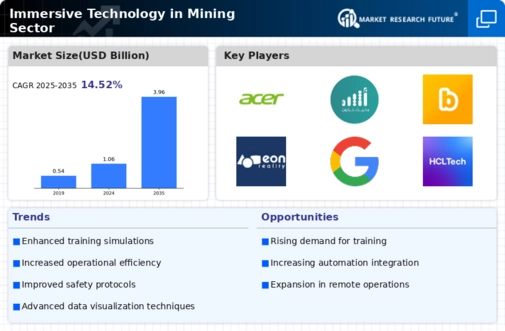Market Analysis
In-depth Analysis of Immersive Technology in Mining Sector Market Industry Landscape
The prevailing trends are driven by several factors affecting the demand for immersive technology solutions in the mining industry, hence transforming it significantly. One of the leading factors that influence the growth of InMining focuses on safety concerns within this sector (InMining.org). By using VR-based systems or AR ones, some companies have an opportunity to help their team member simulate different dangerous situations linked to their activities, such as chemical leaks or explosions inside virtual space, which seems pretty realistic due to its authenticity (Gordon 2018). VR platforms exist that would train miners on methods used while working under dangerous conditions, thus avoiding accidents through self-simulation. In contrast, some AR tools could be put on workers' helmets to monitor their conditions (Gordon 2018). Such training helps build safety awareness amongst employees, reduce workplace accidents, and equip them with navigation skills for such workplaces. Additionally, the improvement of operational efficiency is another significant factor that impacts the market in the mining industry. One of the applications is VR and AR systems used to facilitate remote inspections of equipment and facilities. Hence, there will be no need for manual inspections, thus saving time by reducing downtime (Medina et al., 2020). Furthermore, the Mining sector has been affected by the shift towards remote operations and automation, making immersive technologies attractive. To enable remote monitoring and control, including collaboration within mines, virtual reality (VR) and augmented reality (AR) platforms are increasingly being used by mining companies (Kumari et al., 2021). These include real-time data visualization delivered through VR/AR interfaces as well as remotely controlling gears using a CAVI-based haptic feedback device, thereby enabling experts to support field operators from their offices through voice commands or gestures. Besides, the demand for efficient and effective training programs is fostering the adoption of immersive technologies in the Mining sector. Immersive training solutions, like virtual reality (VR) simulations, are capable of mimicking complicated mining situations to offer hands-on experience. These routines allow workers to practice their skills and familiarize themselves with mining equipment and processes in a safe and controlled environment. Additionally, immersive technology applications have been influenced by growing environmental sustainability concerns as far as mining is concerned. Thus, through immersive visualization tools, it will be possible to undertake environmental impact assessments, among other benefits, such as mine reclamation planning and community engagement. For instance, VR or AR solutions can be used to give stakeholders who would otherwise not have access an opportunity to tour mines virtually, thus enabling them to visualize how mining affects the environment around them while giving them a chance to take part in decision-making processes. These modern sensory development devices facilitate more communal communications between miners and communities.


 Source: Secondary Research, Primary Research, MRFR Database and Analyst Review
Source: Secondary Research, Primary Research, MRFR Database and Analyst Review









Leave a Comment